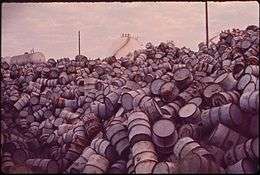Cancer Alley

Cancer Alley (French: Allée du Cancer) is an area along the Mississippi River between Baton Rouge and New Orleans, in the River Parishes of Louisiana, which contains numerous industrial plants. Locations in this area with clusters of cancer patients have been covered by the news media, leading to the "Cancer Alley" moniker.
History
In 1987, when residents of one street in St. Gabriel, Louisiana, primarily African-American and low income, noticed the abundance of cancer cases within their community, “Cancer Alley” became the new name for Jacobs Drive. As similar incidences became more and more prevalent in surrounding areas, the “alley” grew to encompass an eighty-five mile stretch along the Mississippi River. Prior to media coverage of the issue, the area between Baton Rouge and New Orleans was simply known as the “petrochemical corridor”.[1]
In 2002, Louisiana had the second-highest death rate from cancer in the United States. While the national average is 206 deaths per 100,000, Louisiana's rate was 237.3 deaths per 100,000. At the same time, the death rate from cancer in the area dubbed Cancer Alley was higher than the rest of Louisiana, as well as the national average.[2]
In 2000, Toxics Release Inventory (TRI) data showed that Louisiana ranked second throughout the nation for total onsite releases, third for total releases within the state, and fourth for total on- and offsite releases. Louisiana, which has a population of 4,469,970 people, produced 9,416,598,055 pounds of waste in 2000. Seven of the ten plants in the state with the largest combined on- and offsite releases are located in Cancer Alley, and four of the ten plants with the largest onsite releases in the state are located there.[3][4]
In 1969, DuPont opened a plant to manufacture the chemical chloroprene, the main ingredient in neoprene. The plant was sold in 2005 to Japanese chemical company Denka. The area immediately adjacent to the Denka/Dupont neoprene plant in St. John the Baptist Parish has been recognized by the EPA as having the likelihood of getting cancer from air pollution over 700 times the national average. [5] [6]
Cancer studies
In March 2018, a team of students from the Stanford University traveled to Louisiana to implement a household health survey in partnership with Concerned Citizens and the Stanford Human Rights Clinic. These organizations will work with the University Network for Human Rights to produce a report on the environment and health consequences of the industrial emissions in the area.
A peer-reviewed study by Frederic T. Billings III, M.D., found that while Louisiana has a much higher-than-average lung cancer rate, the source is not the "Cancer Alley" parishes, but the other parishes of Louisiana, where above-average tobacco smoking rates are likely the cause of the vast majority of the cancers.[7]
In their 2012 book Petrochemical America, photographer Richard Misrach and Columbia University architecture professor Kate Orff explore the social, environmental, and health impacts of the petrochemical industry in Cancer Alley through photography, writing, and infographic-style illustrations.[8]
British Industrial Metal band Godflesh used an image of a crucifix in a cemetery located near Cancer Alley as the cover art for their 1996 album, Songs of Love and Hate.
See also
References
- ↑ "Cancer Alley: Big Industry, Big Problems". MSNBC. Retrieved 2017-02-21.
- ↑ Tsai SP, Cardarelli KM, Wendt JK, Fraser AE (April 2004). "Mortality patterns among residents in Louisiana's industrial corridor, USA, 1970–99". Occup Environ Med. 61 (4): 295–304. doi:10.1136/oem.2003.007831. PMC 1740760. PMID 15031386.
- ↑ Centers for Disease Control. (2002). Cancer Prevention and Control "Cancer Burden Data Fact Sheets, Louisiana." Atlanta, GA.
- ↑ Coyle, Marcia. (1992). "Company Will Not Build Plant: Lawyers Hail Victory." The National Law Journal, October 19, p. 3.
- ↑ Hersher, Rebecca. "After Decades Of Air Pollution, A Louisiana Town Rebels Against A Chemical Giant". NPR. NPR. Retrieved 21 September 2018.
- ↑ "Cancer Alley, Louisiana". Pollution A - Z. Retrieved 21 September 2018.
- ↑ Billings FT (2005). "Cancer corridors and toxic terrors—is it safe to eat and drink?". Trans. Am. Clin. Climatol. Assoc. 116: 115–24, discussion 125. PMC 1473137. PMID 16555610.
- ↑ Ottinger, Gwen, Ellen Griffith Spears, Kate Orff, and Christopher Lirette. "Petrochemical America, Petrochemical Addiction." Southern Spaces, November 26, 2013.
Further reading
External links
- Cancer Alley, Louisiana from Pollutionissues.com
- Cancer Alley: Myth or Fact?, Unwelcome Neighbors: How the poor bear the burdens of America's pollution. New Orleans Times-Picayune.
- Cancer Alley. BBC.
- Cancer Alley: Big Industry, Big Problems at MSNBC